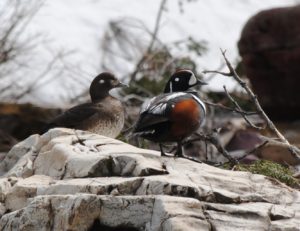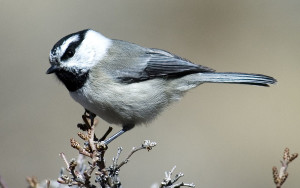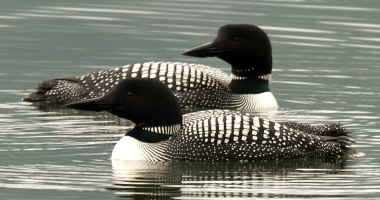Birds & Climate
Montana Audubon recognizes the significant impact to birds from a rapidly changing climate. Birds act as pollinators, keep insect populations in check and are deeply connected to the larger ecological web. They act as an important ecological barometer for understanding how natural systems respond to climate change.
Audubon Climate Report 2019 – Survival by Degrees: 389 Species on the Brink
Our climate is changing, and our birds are among the visual, measurable indicators that make this truth evident. Five years ago, the National Audubon Society released their first climate report, that opened our eyes to the effects climate change may have on both the summer and winter ranges of 314 bird species. This year, a follow-up report based on data from the U.S., Canada, and Mexico, gives us zip code-level detail about potential effects to effects to 604 North American bird species.
In Surival by Degrees: 389 Species on the Brink, scientists assess the exposure risk, adaptive capacity, and sensitivity that bird species have, given a changing climate under three emissions scenarios. In the 2019 report, over 140 million bird observations were used, and it shows that birds are already bearing the consequences of a changing climate.
As an example, the Mountain Plover, a state species of conservation concern and species of the western Great Plains, is predicted to lose 76% of its habitat – facing potential extirpation from the Oklahoma and New Mexico portions of it’s range.
These and many more details about Montana’s birds and climate change from the 2019 report can be found HERE.
Birds Affected by Climate Change in Montana
It may look precarious to us, but nesting on cliff faces behind waterfalls is common sense to a Black Swift. The birds have no trouble weaving behind watery curtains where their nests and chicks remain out of reach for most terrestrial predators.
Over the past four decades, scientists have observed a slow but steady decline in the number of Black Swifts throughout North America (down about 6% each year). Scientists speculate that the species’ declining numbers are caused in part from climate change. For millennia, permanently snowy mountaintops have served as a vital water source, lasting late into the summer when swifts are still nesting. However, in Montana and throughout the Rocky Mountains, the annual snowpack is shrinking as a result of warmer, drier winters. And as water disappears from mountains, so might Black Swifts.
More accurate information is needed about the current condition of the species so Montana Audubon has developed a project to locate nests and record birds in the remote mountain landscapes where they breed.
To learn more about Black Swifts, visit our citizen science project on Nesting Black Swifts in Montana.
Climate change has been indicated as a significant threat to the Harlequin Duck, given their dependence on timing spring runoff so that their nests, often close to the water’s edge, are not submerged. These ducks spend their winters feeding in the turbulent surf along the west cost, migrating inland each April to breed along our fast-moving freshwater streams. In addition to threats from climate change, Harlequin Ducks are also threatened by having a limited amount of suitable habitat from the outset, along with their sensitivity to human disturbance and habitat loss (due to altered runoff).
Given these threats, and the Harlequin’s status as a species of conservation concern, collaborative efforts were started westwide to learn more about the breeding Harlequin Duck population. Since 2016, Glacier National Park and Montana Fish, Wildlife and Parks have joined forces last year to learn specifically about Montana’s birds. Montana Audubon has been assisting with stream surveys, and with the tracking of breeding pairs in Glacier National Park. This work has continued through 2019, and as part of the Montana Audubon River Initiative, and we’ll join the survey effort again this summer.
Because Harlequin Ducks are hard to spot, we are always interested in your observations!
To learn more about surveying for and reporting Harlequin Duck observations, visit our species specific citizen science opportunities.
 In much of its range, the hardy Mountain Chickadee is closely associated with montana conifer forests and backyard bird feeders, even in the dead of winter. An intriguing aspect of National Audubon’s climate model projection is the existence of suitable climate “space” in the Arctic for these birds—in winter, but not in summer—though such a range expansion is unlikely.
In much of its range, the hardy Mountain Chickadee is closely associated with montana conifer forests and backyard bird feeders, even in the dead of winter. An intriguing aspect of National Audubon’s climate model projection is the existence of suitable climate “space” in the Arctic for these birds—in winter, but not in summer—though such a range expansion is unlikely.
Audubon maps that show changing climate suitability for these chickadees are here.
Across the state, Colonial Waterbird species are also being affected by climate change.
Audubon Climate Report

National Audubon’s 2014 Birds and Climate study examines the devastating effect global climate change is likely to have on our birds. It also helps identify the habitat strongholds across North America that they will need in order to hang on – lands we can help protect.
To learn more:
- Visit National Audubon’s birds and climate webpage featuring interactive maps of the 314 species at risk, a technical report, and in-depth stories.
- National Audubon’s How to Be a Climate Hero can give you some great ideas on what YOU can do – and how to learn more about climate change.
- The scientific article associated with National Audubon’s birds and climate report was published September 2, 2015 in the peer-reviewed journal PLOS ONE: Conservation Status of North American Birds in the Face of Future Climate Change.
- Here is a list of MontanaBirds-in-2014-NAS-climate-study, according to National Audubon’s research.
More Information
Join a citizen science project One of the best ways we can track the impacts of climate change in Montana is to monitor our birds. Montana Audubon hosts several citizen science projects, including Climate Watch that allow all to participate.
National Audubon Climate Page A resource for climate news on a national/regional scale.
Boreal Songbird Initiative. Protecting our northern forests is a great way to curtail carbon emissions–and protect songbirds along the way.